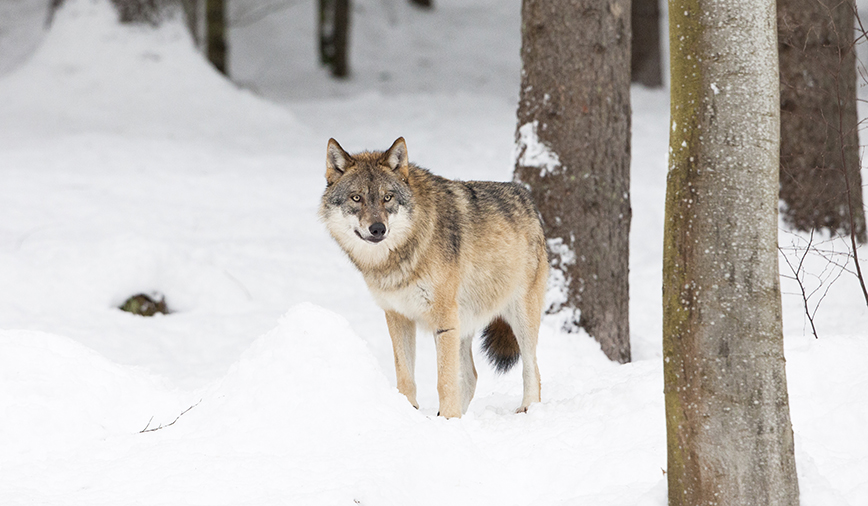January 31, 2014
Wolves
We used to say it could never happen.
As few as 15 years ago, if anyone in our area said, “I think I saw a wolf,” the naturalist community would shake its collective head. “Couldn’t happen,” we’d say. “Not today. Habitat’s gone. Had to be a coyote. Or maybe a wild dog.”
We were sure of ourselves back then. After all, Canis lupus, the gray wolf, also known as the timber wolf, was a federally endangered species. In Illinois, it was considered extirpated—that is, no longer surviving in regions that were once part of its range.
For proof, we had Donald Hoffmeister’s Mammals of Illinois, the definitive reference for fur-bearing critters in our fair state. Right there on page 47, he stated that “probably all wolves were gone from Illinois before the 1860s.” What more confirmation did we need?
But since the 1990s or so, things have started to change. Upper Midwestern gray wolves, afforded the protection of the Endangered Species Act—and the benefit of a burgeoning whitetail deer population—began to thrive in remote regions. First, Minnesota, then Wisconsin and Michigan. By 2004 Wisconsin had removed the wolf from its list of state-endangered species, and in 2012 the animal was delisted federally.
According to data from the U.S. Fish & Wildlife Service’s annual wolf counts, over the winter of 2012-’13 Minnesota’s wolves numbered 2,211; Wisconsin’s came in at 809; and Michigan’s, 658.
Simply put, that’s a lot of wolves.
Consequently, these days, when someone in our area says, “I think I saw a wolf,” I, for one, want to know more. Where was it seen? What did it look like? What was it doing? How big was
it? Although the chances of seeing a wolf in Kane County are extremely remote, we’ve reached the point where we can “never say never.”
One report that intrigued me a few years ago was from a young woman who was attending college in Minnesota. At home in rural Kane County on winter break, she saw an animal “way too big to be a coyote.” Having seen wolves in the wild in Minnesota, she said the animal she saw looked, and acted, very much like a wolf. Wary yet determined, it sniffed at a fencepost before disappearing into the farm landscape.
Another interesting account, this one from Elburn, is much more recent. On January 15, Bryan Salvage was heading to the post office, driving on Route 47 just north of Keslinger Rd when he saw a large, wolf-like animal. “It was running fast, heading west, 50 yards north of the intersection of Keslinger and Rte. 47,” he recounted via email. “It ran from the cemetery into the field across 47. I’m wondering if this animal has a den in the clump of torn down trees to the west of the field as that was the direction it was headed.”
Bryan said he couldn’t stop to see where the animal was going, and he hasn’t seen it since. But the impression he was left with—an animal that was larger than a coyote, with a more rounded, less pointy nose and a grayish, wolf-like coat—was one he’s unlikely to forget any time soon.
Of course any possible wolf sightings will remain just that—unverified possibilities—unless solid DNA evidence is collected.
And the chances of wolves actually reclaiming their niche in northeastern Illinois are still extremely remote. We just don’t have the open space and habitat that wolves, plural, would need to survive. But an isolated individual, passing through on its way to claim new territory?
I think it’s impossible…to never say never again.
—
If you’d like to increase your likelihood of spotting a wolf—as well as a coyote, woodchuck, skunk, porcupine and maybe even a Siberian tiger cub–to 100%, mark your calendar for Saturday February 8th. That’s when Hickory Knolls will be hosting the second of its four 2014
Discovery Days. Attractions that day will include presenters and animals from the Big Run Wolf Ranch in Lockport, as well as sled-dog demonstrations from our friends at Free Spirit Siberian Rescue. Animal presentations will take place at 11am, 12pm and 1pm, and will be accompanied by activities and crafts fitting to this year’s theme: The ‘Ex’ Files: Extirpated, Extinct, Extreme! More info and directions to Hickory Knolls can be found at www.stcnature.org.
Pam Otto is the manager of nature programs and interpretive services at the Hickory Knolls Discovery Center, a facility of the St. Charles Park District. She can be reached at 630-513-4346 or potto@stcparks.org.

